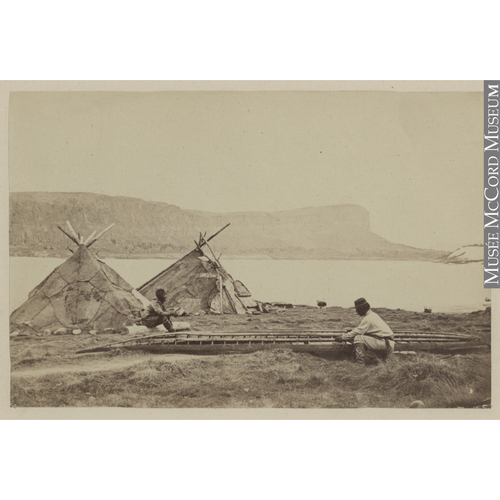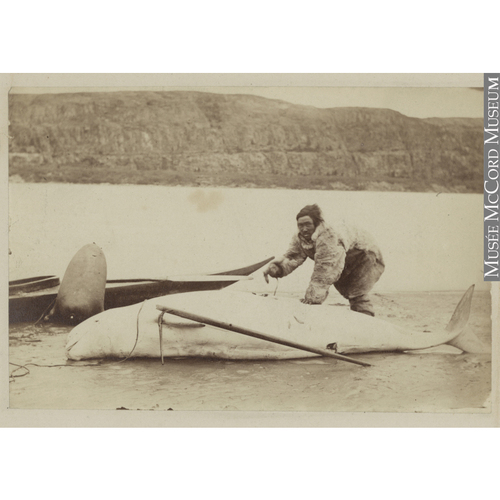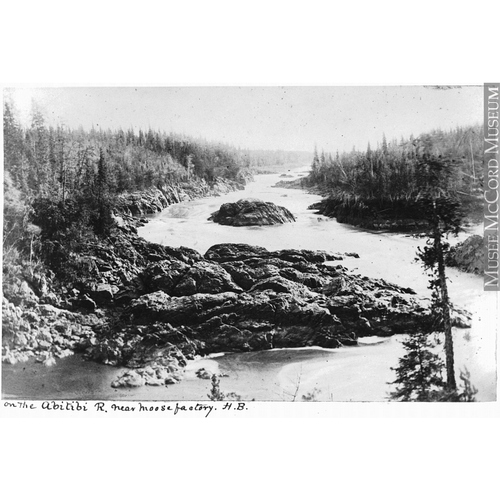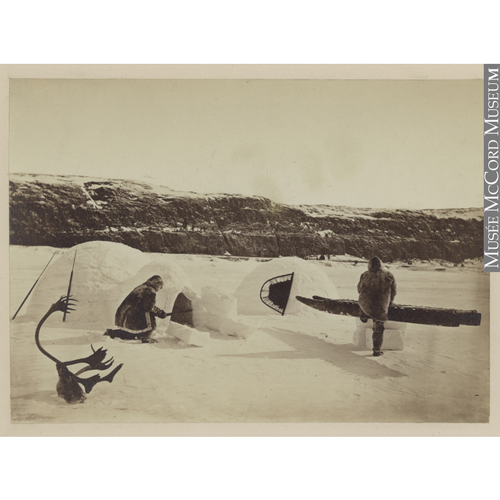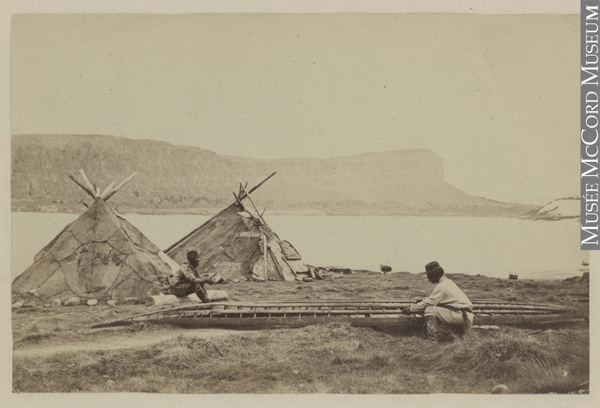
Source: Link
COTTER, JAMES LAURENCE, HBC fur-trader and photographer; b. 24 Dec. 1839 at Jaulna (Jalna), India, son of Colonel George Sackville Cotter and Agnes Kilgour; m. 13 Sept. 1868 at Sault Ste Marie, Ont., Frances Symington Ironside, daughter of George Ironside*, and they had 11 children; d. 6 Aug. 1889 at Sault Ste Marie.
James Laurence Cotter, a descendant of an Irish baronet, was brought up by his grandmother near Edinburgh, where he attended Loretto School. He arrived in Canada in 1857 and joined the Hudson’s Bay Company that fall as an apprentice clerk. Governor George Simpson* described him as “a young gentleman of good education” and sent him to Fort La Cloche (Ont.) on Lake Huron, where he was to be kept “actively engaged” and pick up the “French & Indian” languages. Cotter served two seasons at Bersimis (Betsiamites, Que.) and another at Fort Chicoutimi (Que.) as a clerk and was then transferred to Moose Factory (Ont.), the administrative headquarters of the HBC’s Southern Department. At Moose Factory, where he arrived in October 1867, Cotter was initiated into the complexities of a large fur-trading centre. In 1872 he was assigned to the Eastmain District and made junior chief trader the following year. He recommended to George Simpson McTavish, officer-in-charge at Moose Factory, that the district headquarters be moved from Little Whale River (Petite rivière de la Baleine, Que.) to Fort George (Que.). McTavish agreed, and the move was made in the summer of 1874. Cotter was promoted to chief trader in 1875, and remained at Fort George for another year, until he was sent to Rupert’s House (Fort-Rupert, Que.) to take charge of Rupert’s River District.
In 1879 Cotter returned to Moose Factory to take charge of the Southern Department, which comprised the districts of Albany, Rupert’s River, Eastmain, Moose Factory, New Post (on the Abitibi River), and Kenogamissi (on the Moose River). The 1880s were a period of important changes in the development of northern Ontario: the building of the Canadian Pacific Railway and the opening up of the northwest to settlement were, in Cotter’s words, “beginning to have their effect in unsettling the minds of the people.” This general instability was reflected in the difficulty Cotter experienced in retaining qualified staff, especially skilled mechanics and boat builders. He was, however, successful in obtaining higher wages and better pensions for the men. He also succeeded, despite the restrictions on space in company ships, in having the wives and families of his staff brought out and housing provided for them. As settlement advanced to the north and west, the Indians too were affected. They were exposed to epidemics of whooping cough and influenza, which invariably meant death and sorrow, a decrease in fur returns, and an increase in their debts. To protect the Indians, Cotter prevailed upon them not to travel in areas afflicted by contagious diseases. During this unsettling period, Cotter, who attained the rank of chief factor in 1883, kept the fur returns for the Southern Department reasonably stable. His interests went beyond the fur trade. He established a sawmill for the HBC at Moose Factory, brought in livestock to improve the company’s herd, and planted several productive vegetable gardens.
It is perhaps as a photographer, however, and not as a company officer that Cotter is best remembered. He made his own camera, and took some of the first photographs of the area around Hudson Bay. Nine drawings in Harper’s Weekly (New York) of 7 June 1879, for instance, were based on Cotter’s photographs. Historians and anthropologists are particularly interested in the artistically composed, sharp, clear photographs of people, buildings, and transportation. One of his photographs, taken at Moose Factory in 1871, shows a flat-roofed building which probably dates from 1762. Others show the Moose Factory bell tower, double-masted coastal vessels, the fort cannon pointing out to James Bay, and Indians and canoes. His pictures capture scenes reminiscent of a life which had changed little since the establishment of the fort in 1673. Cotter’s photographs of the Inuit of the Eastmain District at Little Whale River, with their skin tents and kayaks, are probably the first photographs from that area.
During the winter of 1888–89 Cotter was too ill to work. He and his family left Moose Factory for Sault Ste Marie, where he died on 6 August.
Some of J. L. Cotter’s photographs are reproduced in “The Eskimos of Eastmain,” Beaver, outfit 260 (1929–30), 301–6 and 362–65, and in the photo essay of J. L. Cotter and C. P. Wilson, “Moose Factory today and yesterday,” Beaver, outfit 277 (June 1946), 22–29.
PAM, HBCA, James Cotter file; George Simpson McTavish file; George Simpson genealogical table; A.1/71: 74; A.1/149: 204; A.6/13: ff.72d–73d; A.6/52: 320–21; A.6/53: 93, 523; A.6/55: 259; A.11/43: f.128d; A.11/47: ff.217, 229d, 234, 262b, 266b, 272, 280, 280d, 281, 289d, 291, 292, 293d, 294, 294b, 294d, 303, 408, 414; A.11/149: 104; A.44/8: 212; B.17/a/1: f.9d; B.77/a/39: ff.20d, 21; B.77/a/40: f.6d; B.134/g/39: f.13d; B.134/g/40: f.14d; B.135/a/181: f.18d; B.186/a/99: ff.13, 25d, 26, 31d, 72d; B.373/a/5: ff.56d, 70, 72; B.373/a/6: f.6d; B.373/c/2: f.44d; D.4/53: ff.65d, 88, 88d; D.14/2: f.510; D.14/5: f.262; D.14/8: f.79; D.20/15: f.275d; D.20/29: f.326d. H. M. S. Cotter, “Chief factor and photographer,” Beaver, outfit 264 (December 1933): 23–26.
Cite This Article
Shirlee Anne Smith, “COTTER, JAMES LAURENCE,” in Dictionary of Canadian Biography, vol. 11, University of Toronto/Université Laval, 2003–, accessed December 28, 2025, https://www.biographi.ca/en/bio/cotter_james_laurence_11E.html.
The citation above shows the format for footnotes and endnotes according to the Chicago manual of style (16th edition). Information to be used in other citation formats:
| Permalink: | https://www.biographi.ca/en/bio/cotter_james_laurence_11E.html |
| Author of Article: | Shirlee Anne Smith |
| Title of Article: | COTTER, JAMES LAURENCE |
| Publication Name: | Dictionary of Canadian Biography, vol. 11 |
| Publisher: | University of Toronto/Université Laval |
| Year of publication: | 1982 |
| Year of revision: | 1982 |
| Access Date: | December 28, 2025 |


